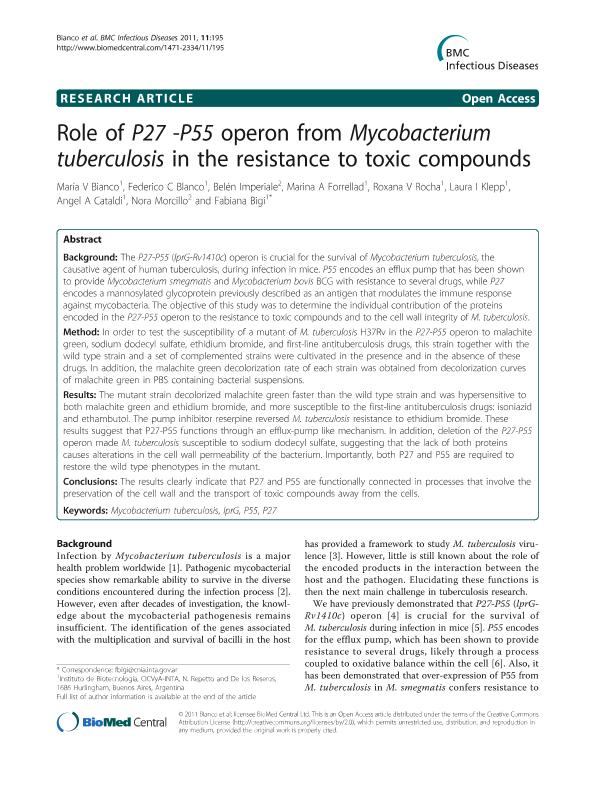Mostrar el registro sencillo del ítem
dc.contributor.author
Bianco, María V.
dc.contributor.author
Blanco, Federico Carlos

dc.contributor.author
Imperiale, Belén Rocío

dc.contributor.author
Forrellad, Marina Andrea

dc.contributor.author
Rocha, Roxana V.
dc.contributor.author
Klepp, Laura Ines

dc.contributor.author
Cataldi, Angel Adrian

dc.contributor.author
Morcillo, Nora Susana

dc.contributor.author
Bigi, Fabiana

dc.date.available
2023-03-01T15:38:27Z
dc.date.issued
2011-07
dc.identifier.citation
Bianco, María V.; Blanco, Federico Carlos; Imperiale, Belén Rocío; Forrellad, Marina Andrea; Rocha, Roxana V.; et al.; Role of P27 -P55 operon from Mycobacterium tuberculosis in the resistance to toxic compounds; BioMed Central; BMC Infectious Diseases; 11; 7-2011; 1-9
dc.identifier.issn
1471-2334
dc.identifier.uri
http://hdl.handle.net/11336/189236
dc.description.abstract
Background: The P27-P55 (lprG-Rv1410c) operon is crucial for the survival of Mycobacterium tuberculosis, the causative agent of human tuberculosis, during infection in mice. P55 encodes an efflux pump that has been shown to provide Mycobacterium smegmatis and Mycobacterium bovis BCG with resistance to several drugs, while P27 encodes a mannosylated glycoprotein previously described as an antigen that modulates the immune response against mycobacteria. The objective of this study was to determine the individual contribution of the proteins encoded in the P27-P55 operon to the resistance to toxic compounds and to the cell wall integrity of M. tuberculosis.Method: In order to test the susceptibility of a mutant of M. tuberculosis H37Rv in the P27-P55 operon to malachite green, sodium dodecyl sulfate, ethidium bromide, and first-line antituberculosis drugs, this strain together with the wild type strain and a set of complemented strains were cultivated in the presence and in the absence of these drugs. In addition, the malachite green decolorization rate of each strain was obtained from decolorization curves of malachite green in PBS containing bacterial suspensions.Results: The mutant strain decolorized malachite green faster than the wild type strain and was hypersensitive to both malachite green and ethidium bromide, and more susceptible to the first-line antituberculosis drugs: isoniazid and ethambutol. The pump inhibitor reserpine reversed M. tuberculosis resistance to ethidium bromide. These results suggest that P27-P55 functions through an efflux-pump like mechanism. In addition, deletion of the P27-P55 operon made M. tuberculosis susceptible to sodium dodecyl sulfate, suggesting that the lack of both proteins causes alterations in the cell wall permeability of the bacterium. Importantly, both P27 and P55 are required to restore the wild type phenotypes in the mutant.Conclusions: The results clearly indicate that P27 and P55 are functionally connected in processes that involve the preservation of the cell wall and the transport of toxic compounds away from the cells.
dc.format
application/pdf
dc.language.iso
eng
dc.publisher
BioMed Central

dc.rights
info:eu-repo/semantics/openAccess
dc.rights.uri
https://creativecommons.org/licenses/by/2.5/ar/
dc.subject
MYCOBACTERIUM TUBERCULOSISL
dc.subject
P27
dc.subject
P55
dc.subject
PRG
dc.subject.classification
Biología Celular, Microbiología

dc.subject.classification
Ciencias Biológicas

dc.subject.classification
CIENCIAS NATURALES Y EXACTAS

dc.title
Role of P27 -P55 operon from Mycobacterium tuberculosis in the resistance to toxic compounds
dc.type
info:eu-repo/semantics/article
dc.type
info:ar-repo/semantics/artículo
dc.type
info:eu-repo/semantics/publishedVersion
dc.date.updated
2023-02-21T22:18:07Z
dc.journal.volume
11
dc.journal.pagination
1-9
dc.journal.pais
Reino Unido

dc.journal.ciudad
Londres
dc.description.fil
Fil: Bianco, María V.. Instituto Nacional de Tecnología Agropecuaria. Centro de Investigación en Ciencias Veterinarias y Agronómicas. Instituto de Biotecnología; Argentina
dc.description.fil
Fil: Blanco, Federico Carlos. Consejo Nacional de Investigaciones Científicas y Técnicas; Argentina. Instituto Nacional de Tecnología Agropecuaria. Centro de Investigación en Ciencias Veterinarias y Agronómicas. Instituto de Biotecnología; Argentina
dc.description.fil
Fil: Imperiale, Belén Rocío. Consejo Nacional de Investigaciones Científicas y Técnicas; Argentina. Provincia de Buenos Aires. Ministerio de Salud. Hospital "Dr. Antonio A. Cetrángolo"; Argentina
dc.description.fil
Fil: Forrellad, Marina Andrea. Consejo Nacional de Investigaciones Científicas y Técnicas; Argentina. Instituto Nacional de Tecnología Agropecuaria. Centro de Investigación en Ciencias Veterinarias y Agronómicas. Instituto de Biotecnología; Argentina
dc.description.fil
Fil: Rocha, Roxana V.. Instituto Nacional de Tecnología Agropecuaria. Centro de Investigación en Ciencias Veterinarias y Agronómicas. Instituto de Biotecnología; Argentina
dc.description.fil
Fil: Klepp, Laura Ines. Consejo Nacional de Investigaciones Científicas y Técnicas; Argentina. Instituto Nacional de Tecnología Agropecuaria. Centro de Investigación en Ciencias Veterinarias y Agronómicas. Instituto de Biotecnología; Argentina
dc.description.fil
Fil: Cataldi, Angel Adrian. Consejo Nacional de Investigaciones Científicas y Técnicas; Argentina. Instituto Nacional de Tecnología Agropecuaria. Centro de Investigación en Ciencias Veterinarias y Agronómicas. Instituto de Biotecnología; Argentina
dc.description.fil
Fil: Morcillo, Nora Susana. Provincia de Buenos Aires. Ministerio de Salud. Hospital "Dr. Antonio A. Cetrángolo"; Argentina
dc.description.fil
Fil: Bigi, Fabiana. Consejo Nacional de Investigaciones Científicas y Técnicas; Argentina. Instituto Nacional de Tecnología Agropecuaria. Centro de Investigación en Ciencias Veterinarias y Agronómicas. Instituto de Biotecnología; Argentina
dc.journal.title
BMC Infectious Diseases

dc.relation.alternativeid
info:eu-repo/semantics/altIdentifier/url/https://bmcinfectdis.biomedcentral.com/articles/10.1186/1471-2334-11-195
dc.relation.alternativeid
info:eu-repo/semantics/altIdentifier/doi/http://dx.doi.org/10.1186/1471-2334-11-195
Archivos asociados
